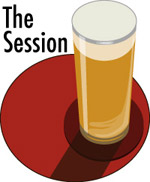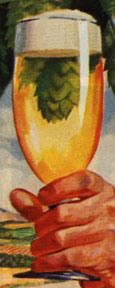 Was it good for you?
Was it good for you?
Dryly sweet perhaps. Light and fluffy? Espresso and bitter cocoa. Maybe even structured.
The approaches to writing about the broad subject of stouts were as diverse as the stouts themselves for our first round of The Session. We got a little history, a little philosophy, some comparisons, a bit of travel and – of course – haiku. The official topic this month was Not Your Father’s Stout, and if you’re trying to figure out what this means here’s the history (ala blogs, in reverse order).
– Let’s start with the haikus. Captain Hops conjured them up for both Young’s Oatmeal Stout and Oak Aged Yeti Imperial Stout at Beer Haiku Daily.
– Not all the contributors even write regularly about beer. Martini Republic offered up cocktails made with stout, including something called a Dog’s Nose. As an aside, Stephen Beaumont has a A Six-Pack of Stout Cocktails this month at World of Beer (his site, as opposed to where he blogs).
– Stephen joined the stoutfest in two blogs, nicely making my point about finding different approach with his words about Jacobsen Coffee Mint Stout at That’s The Spirit and O’Hara’s Irish Stout at On the House. O’Hara’s was the only Irish-brewed stout we reviewed (in part because Ireland’s Big Three were ruled out at the start).
– Another Canadian, Alan at The Good Beer Blog, found several stouts in his cellar he’s been waiting to try before settling on Avery Out of Bounds Stout from Colorado.
– Also from Canada, Greg at Beer, Beats & Bites couldn’t make up his mind and ended up writing about five stouts, three from Canada and a pair from the U.S.
– Stonch of Stonch’s Beer Blog provided the final international contribution – I expect more to join in the coming months. He reminds us that America doesn’t have a monopoly on microbreweries, reviewing Pitfield Shoreditch Stout.
– Tomme of Port Brewing/Lost Abbey was one of two commercial brewers heard from. He wrote about Port’s award-winning Seaside Stout – and provided a tip on brewer watching.
– And Andrew at the Flossmoor Beer Blog previews Flossmoor Station’s milk stout (it debuts this week in conjunction with a breakfast buffet – there’s a way to start the day).
– Keeping in the spirit of milk stouts, Ray at the Barley Blog put a bottle of Old Rasputin back in the fridge to try Mackeson XXX Stout, a beer he’d never had before.
– Al and Ron at Hop Talk warmed to the task by considering the history of the stout style, then they wrote separate reviews of Rogue Shakespeare Stout.
– No surprise that Lew at Seen Through a Glass did a little traveling to taste The Three Faces of Stout, all Pennsylvania beers he consumed where they were brewed. (One of them a milk stout.)
– At his Brookston Beer Bulletin, Jay stuck close to home with an old favorite, San Quentin’s Breakout Stout, consumed where it is brewed. It took a while to get to stout as he considered some of the discussions about writing about and evaluating beer that have been going on recently.
– Rick at Lyke 2 Drink also went to the source – after thoroughly preparing himself with by tasting stouts from here and there. He admits he picked Foothills Sexual Chocolate Imperial Stout in part because of the name.
– If a monthly hosts declares a “drink local” theme a lot of contributors should be set. Jon at the Brew Site picked a hometown beer – is he rubbing in the fact that he has Deschutes Brewery in his town? – in Obsidian Stout.
– cosmicpenguin.net’s Jordan works just block from Left Hand Brewing, but resisted picking Left Hand Milk Stout (my choice) and instead tapped beers new to him, Flying Dog Gonzo Imperial Porter and Avery Out of Bounds Stout (yes, the same one Alan wrote about).
– Perhaps Jonathan from the Beer Mapping Project is in denial, disregarding the fact that Bell’s has discontinued selling its beer in Illinois. He opened a bottle Expedition Stout to kick off a weekend that included the Night of the Living Ales and Goose Island Stoutfest. He told us, “I plan to drink my share of stouts (and possibly yours) this weekend.”
– Eli of foureyed(beer)geek added his favorite coffee stout to the mix. Schlafly Kaldi’s Coffee Stout has the Schlafly Oatmeal Stout at its base and uses a cold toddy method of extraction for the coffee.
– Jessie Jane at Bar Stories had hoped to whip up some ice cream for her session, but with time short decided to accompany Wolaver’s Organic Oatmeal Stout with a ramble.
– While Ray put the North Coast Old Rasputin back in the fridge, Dann at Dann Drinks Beer didn’t. It was beer #60 on his march to 365 for the year.
– Tedo at Barley Vine joined Captain Hops in drinking a Young’s stout, but made his the Double Chocolate Stout.
– Matt of Song of Myself first told us, “Shout it out from the top of your lungs: I LOVE BURNT BARLEY BABY.” Then he tasted a half dozen Midwestern stouts, only one of them from Bell’s.
– When you read across the posts you’ll see that Brooklyn Black Chocolate Stout keeps coming up, whether it was a beer that almost got consumed or if it was one of several. Both Adam and Bryan at The Brew Lounge included Black Chocolate – in fact Bryan “dove headfirst into his” (quite an image, yes?).
– Yes, this Brooklyn Black Chocolate Stout, which Jim at Bostonbeerman Blog freely admits is one of his all-time favorites.
– Finding himself in Sandpoint, Idaho, Ben from SevenPack.net grabbed a six-pack of Laughing Dog Sweet Stout brewed just up the road in Ponderay.
– Andrew, andrew ager, dot com, found himself instead in his basement, where My Own Private Stout, Oh-Ho.
– Also on the homebrewing front, Chris at Beer Activist Blog arrived late (that’s OK) with an Organic Irish Stout.
– At the Fredericksburg Area Brewing and Tasting Society, James evaluated Shipyard Blue Fin Stout by comparing it to Guinness.
– And what might have been at last call (almost midnight on the West Coast), Bill Brand of What’s On Tap finished off the evening with Drake’s Imperial Stout.
Last call unless I left somebody out ;< ( Please e-mail a link if I missed your post.
 Alan has written. The theme for the second round of The Session
Alan has written. The theme for the second round of The Session  I like – OK, love – hops more than most people you know. But I understand the frustration expressed by some brewers about the attention that highly hopped high alcohol beers (sometimes called extreme) receive.
I like – OK, love – hops more than most people you know. But I understand the frustration expressed by some brewers about the attention that highly hopped high alcohol beers (sometimes called extreme) receive.